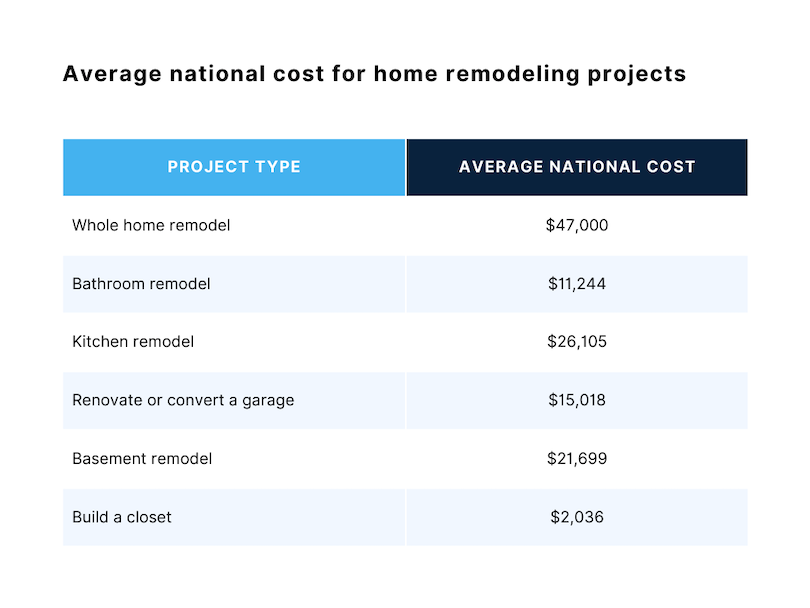2023 looks to be a banner year for home improvements.
A recent Clever Real Estate study revealed that more than half (55%) of home buyers purchased a fixer-upper in 2022. And with current homeowners locked into below-market interest rates, many are pulling their homes off the market and staying put.
As anyone who's taken on a renovation will tell you, home improvement costs can quickly add up when updating or flipping a house.
In fact, 80% of remodelers went over their budget in 2022, according to HouseMethod — with one in seven surpassing their budget by $5,000 or more.
So, how can you add value without breaking the bank? We turned to expert renovators for their best cost-cutting strategies, including where to save on materials and labor.

9 Ways to Cut Costs on Your Next Renovation
1. Set a realistic budget.
A home renovation requires a significant investment of time and money. But even small improvements can add to your home’s value, style, and function.
The increased value of your home can result in a higher return on investment and make your listing more attractive to buyers if you decide to sell.
>>CURIOUS HOW MUCH YOUR HOME IS WORTH? Calculate your current home value.
But it’s essential to establish a realistic budget — and stick to it.
When setting your budget, consider factors such as:
- Labor costs
- Cost of materials
- Fees for permits, if necessary
- Potential delays due to local code regulations
Additionally, home renovation costs vary based on your location, square footage, type and complexity of the renovation, any hidden underlying issues, time of year, and materials.
Given this variability, how can you determine a realistic estimate of your home renovation project?
Fortunately, you can use online remodel cost calculators to estimate your area (like the one by HomeAdvisor). Then, talk to multiple contractors or subcontractors to get a better feel for rates where you live.
How much does it cost to renovate a house?
To help you start planning a budget, here is a list of the average national cost for common home renovation projects, according to HomeAdvisor.

Source: HomeAdvisor
>>OUTSMART THE MARKET with Clever's weekly email on all things housing. Get the clarity you need to buy, sell, and build equity in today's housing market.
2. Give yourself plenty of time for planning.
"Don’t rush into a renovation — take your time to plan, research, and get advice. This will help ensure your project is within your budget," recommends Martin Orefice, the CEO of Rent To Own Labs.
He also suggests starting small. "You can plan for bigger renovations down the road."
The planning phase allows you time to compare prices on materials and labor and get feedback on your options before starting the work.
Consider both your design wishes and budget before selecting what materials to buy. For example, luxury finishes and appliances can quickly increase your budget. So, you may need to prioritize what’s most important to you.
Cody Neumann, a real estate entrepreneur with Turbo Cash Home Buyer, recommends "investing money into major structural changes first. These often add more value to the property than cosmetic changes."
3. Think outside the box to save on the cost of materials.
Comparing prices at multiple stores can help you save on materials. But if you’re willing to think outside the box, you can often find additional ways to save while still getting quality materials.
Here are six strategies experts suggest to save on the cost of materials.
1. Join local community Facebook groups.
David Hampshere, the CEO of Purple Egg Real Estate, has found inexpensive yet quality rehab materials through his community Facebook group.
"I’ve been surprised by the things some homeowners are willing to get rid of, and it’s often free — curbside pick up, first come, first serve. I have picked up tile, tools, paint, flooring, and even a new bathroom faucet."
2. Shop at Habitat for Humanity or similar reclamation stores.
Reclamation stores can save you money on gently used items, says Robert Taylor of The Real Estate Solutions Guy.
"You can also find retro items, replacement parts, and even new items. Additionally, items like HVAC registers, lighting, and tile are often a fraction of the big box stores. While it’s often hit or miss with these stores, inventory changes regularly, so it’s worth a periodic trip to see what’s currently in stock."
3. Shop for appliances on or before major holidays.
Robert Taylor recommends buying appliances near or on major holidays to save money.
"Most big box stores have major sales on appliances around major holidays. These sales can easily save you a few hundred dollars even on basic appliances."
4. Look for less expensive alternative materials.
"If your contractor is quoting a high price for a certain material, see if there is a cheaper alternative that will get the job done," recommends Beril Yilmaz, an interior designer and architect at By Design and Viz. "Also, don’t buy the first thing you see. Research different brands and find the best deals."
5. Buy in bulk and look for coupons or discounts.
Pratik Pathapati suggests going to the pro desk at stores like Lowes and Home Depot to inquire about volume discounts. "Create a list of the things you need before talking to them. They’ll run it through their system and let you know what discount you’d receive."
Beril Yilmaz also recommends looking for coupons and bargaining with sellers. "You may be surprised at how much they’re willing to lower their prices."
6. Check with local contractors and search for homes being renovated in your area.
"Check with local contractors and reuse centers for reclaimed items you can use," recommends Shaun Martin, the owner and CEO of The Home Buying Company. "You also can often find recycled building materials from local businesses who have recently remodeled or demolished a structure."
Diane Gonzalez, a real estate agent at Rodeo Realty, recommends searching for homes being renovated in your area. "When builders are remodeling, they often get rid of useful items that are still in good condition. They often will give them to you for free if you pick them up."
4. Get creative with color and materials.
Chris Alexakis, an interior designer and founder of Cabinet Select, looks for ways to incorporate color and texture in your design to save money.
For example, he recommends looking for opportunities to use wallpaper, paint, or fabric instead of expensive tile or stone. "You’ll be surprised at how much of a difference these subtle changes can make."
He suggests looking at sample boards or experimenting with small amounts of different materials before settling on your design.
5. Find creative ways to reuse or recycle materials.
Reusing materials is better for the environment and saves you money.
Matt Hagens suggests finding materials at salvage yards and architectural salvage stores. "Websites such as Second Use and Habitat ReStore often have an abundance of items such as doors, windows, cabinets, reclaimed wood, and other materials that can be used creatively in renovation projects."
Here are some creative ideas for reused or recycled materials.
- Robert Taylor suggests upgrading an old shower or tub by changing the color with epoxy refinishing. "If the tile and grout are in good condition, a refinishing contractor can apply epoxy, making your bathroom dramatically different for under $1,500. Plus, recoating a shower or tub lets you avoid tearing out a bathroom."
- Beril Yilmaz recommends reusing materials you have in other parts of your home. "For instance, if you’re replacing your kitchen countertops, see if you can use the old ones in your laundry room or outdoor kitchen."
- Victoria Shockley, senior maintenance coordinator at Utopia Management, has found old flooring can be reused as an accent wall.
- Ryan Meagher suggests repainting interiors that are in good condition, reusing lighting or fixtures in other areas of your home, and selling materials of value that you can’t repurpose in your new design.
6. Do some of the work yourself.
Labor costs are expensive, so doing some of the work yourself can save you money — if you have the necessary skills and time.
Look for less demanding tasks that you can find tutorials on, like painting, tiling, laying floors, or sanding floors.
But remember that DIYing can cost you money if you take on tasks that exceed your capacity.
How do you decide whether to do the work yourself or hire someone?
Matt Hagens, a carpenter and the founder and CEO of Obsessed Woodworking, says to consider the time and skill required to complete the task. "If it requires specialized skills, knowledge, tools, or will take a long time to complete, it may be best to hire someone."
Alex Byder, the owner of BD Home Holdings, recommends watching "how to" videos to better understand the scope of a job before starting. "One video should be enough to learn how difficult the job is. From there, compare the money you are saving by doing the job yourself to the time you will spend doing it."
7. Talk to multiple subcontractors and ask questions before hiring one.
Contact multiple subcontractors before deciding on one. Taking the time to compare quotes and ask questions can save you money and allow you to get different experts’ opinions on your project.
Additionally, talk to references for each subcontractor before hiring to ensure the customer experience matches up with their pitch.
Before hiring someone, Ryan Meagher of BVM Contracting LAO suggests "asking each subcontractor what you can do to lower the costs or alleviate the amount of labor they will need to allocate for the project."
This step can save you significant money, as Ryan Meagher discovered during his current DIY renovation.
"I was installing a completely new cold-climate heat pump system. I was getting pricing in the range of $80,000 to $100,000 for full service. But I found a subcontractor that would allow us to complete a lot of the labor-intensive work. I ended up only spending around $40,000."
8. Hire handy people or day laborers for small jobs.
Short-term workers often charge lower hourly rates than general contractors. Consider hiring them for smaller tasks such as patching drywall, hanging blinds, or painting furniture.
Cody Neumann also recommends checking with local universities or community centers for student workers who can help you with these smaller tasks.



